Rapid Transit Options in York Region
This is an updated idea outlining options for rapid transit in York Region using funding estimates for proposed rapid transit expansion, namely an extension of the Yonge subway line to Richmond Hill Centre. The previous version of this took into account the funding for the Spadina subway extension, but as that project is now underway, this has been updated to exclude those funds. The original page remains available for comparison.
Mode: BRT, LRT or Subway?
This page will look into comparing LRT and Subway rapid transit options for York Region, with focus on a proposed Yonge Subway extension to Richmond Hill. To get an understanding of what the terms LRT and Subway mean (along with BRT, Commuter Rail, and DMU), take a look at this page. Commuter rail and DMU have their places, and GO Transit provides three corridors of service in York Region. In considering rapid transit expansion, the other three are the viable options available.
This page will look at the various alternative options to a Yonge Subway extension that are possible with the same capital cost or less. This should be obvious, but these are not official plans, just ideas. To quote transit activist Steve Munro, "the moment someone draws a map, the concrete starts to harden and people treat proposals as done deals", so please keep that in mind!
After taking a look, post your comments on the LRT Blog here.
The plans to move VIVA to phase 2, that would provide a true BRT implementation, should move ahead as soon as possible across parts of the VIVA system that are not yet ready for greater capacity. Construction is already underway along Enterprise Drive in Markham between Warden and Birchmount as well as along Davis Drive in Newmarket, with the Enterprise Drive portion scheduled to open in the near future.
Eventually, these may need to be upgraded to LRT operations, but if a central portion were to be built with LRT today, instead of Subway, future expansion using LRT technology is made simpler.
One great benefit of LRT is it is more cost effective for incremental expansion. This not only means extending existing lines or adding new lines, but it also means expanding platform lengths to allow 3-car operation instead of 2-car operation (a 50% increase in capacity for a small capital cost and a negligible increase in operating cost).
Unfortunately, construction is underway to extend the Spadina subway line up to Highway 7 near Jane in Vaughan, despite the lack of the need for this level of capacity. The reach of an LRT system that could be built for the same money that will be used to build the 8.6 km of subway extension is significant. For an idea of this, see the original version of this page.
The VivaNext plans include the construction of a Yonge subway extension to Highway 7 at Richmond Hill Centre. This page will look at what could be done with the same funding if the portion of this north of Steeles were to be built using LRT.
The lower cost of LRT implementation can mean that a greater degree of LRT can be built with the same funding. Alternatively, given current economic conditions, if funding may have to be limited, perhaps we should consider LRT as a way to provide the currently needed capacity for a lower cost that is also a cost effective way to expand for future needs.
For the same cost as subway construction, LRT can provide the level needed to a greater number of riders and potential riders. This greater penetration of a rail-based rapid transit implementation at this time would also result in a savings in both funds and inconvenience of constructing BRT lanes at this time over these areas.
The Yonge Street corridor north of Highway 7, definitely to Major Mackenzie Drive and possibly to Elgin Mills Road, and at least 5 km each way at Yonge along Highway 7 are corridors that can be identified as areas that will need to move to Phase 3 at some point in the future. LRT technology could provide more than ample capacity for the foreseeable future.

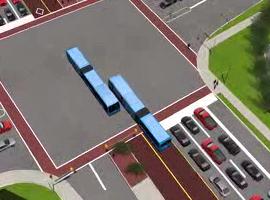
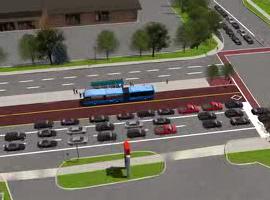
Before we go into the specifics of comparing the cost of LRT versus Subway, take a look at what typical costs of construction of these two modes actually are on this page. In summary, these are typical costs (not including vehicles):
Subway underground: $250-300 million per kilometre
Subway at grade: $150-200 million per kilometre
The Yonge extension as proposed is expected to cost another $2.4 billion for a total of just over 6 kilometres. It should be noted that only about $1.4 billion of that is for the extension north of Steeles, as this site will propose building the extension to Steeles and will look at what that $1.4 billion can do if used for LRT construction.
Typical LRT costs are as follows (including vehicles):
LRT underground: $130-225 million per kilometre
LRT at grade: $30-60 million per kilometre
For an understanding on the capacities available with LRT and Subway, take a look on this page.
Everyone knows what to expect when the TTC Subway is extended, so why not just go with more of that? After all, who is going to say "no" if the province or the feds are offering money for more of that? It is your tax dollars that are being offered, and should we not look into what mode can benefit the greatest number of people for the same amount of money?
Would you pay for something and use half its potential?
Subway expansion is very costly, so it is imperative that the expense be justified. Is the capacity that a full Subway necessary now? In the near future? In the longterm future? Ever? If not, then perhaps some trains will turn back at Finch or perhaps Steeles. That means that some people destined for stops north may have to get off a train and wait for the next one to complete their trip. Will it ever be necessary, or even possible to run every train all the way to Highway 7.
To understand the reason why, one must consider just how frequently a train can be run. There is a good explanation of this on Steve Munro's website at this location and at this location.
Over the next few years, the signaling system on the Yonge line will be replaced because the age of the system is making its maintenance more costly as time goes on. This new system will allow a shorter headway compared to the current 150 second headway (2 minutes, 30 seconds). A 90-second headway has been suggested, but a headway of about 110 seconds is more realistic. This will increase the capacity of the line by about 20%. This is part of the conditions needed for the extension on Yonge to Highway 7.
The problem is that even with the new signaling system, it is physically impossible to reduce the headway below 120 seconds at terminals. Realistically, the practical lower limit is more like 140 seconds as this leaves a small amount of headroom to compensate for variations from operator's reaction time to passengers attempting to squeeze into doors at the very last moment. There are two ways to get around this: a loop terminal or multiple turn-back pocket tracks.
Loop Terminal
The first is to not have a stub-end terminal where trains arrive, operator changes ends, and leaves in the opposite direction. Instead, a turning loop is used. A train arrives and unloads passenger on one track, then leaves empty to enter a loop.
The empty train traverses the loop and returns to the loading platform. This changes the terminal operation to be the same as any other station on the line. An alternative would be to have the terminal station on the loop itself, with one stop opening doors on one side for unloading followed by opening doors on the other side for loading.
This alternative, however, restricts the ability to extend the line without major reconstruction of the terminal station. Another major problem with a loop is that it can be very large, depending on how fast one plans to operate trains over the loop.
According to the Subway Operations Report for the Spadina Extension, the desired minimum radius is 750 metres, but the absolute minimum radius is 300 metres. A train without passengers could take a sharper turn at a higher speed, but if carrying passengers, it would be rather discomforting if the curve were entered at a higher speed.
Plans for a Yonge extension do not call for a loop, so the cost of the loop is not part of its expected costs. However, to get an idea of the space required for a loop with a 500 metre radius, click on the image to the right.
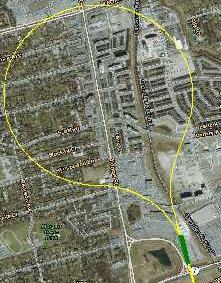
How large is a 500 metre radius loop?
With a terminal station under the current Richmond Hill Centre VIVA station, this gives a rough idea.
Multiple Turn-back Pocket Tracks
A more cost-effective solution is to turn trains back using a centre "pocket" track beyond the terminal station. A train arrives and unloads passenger on one track, then leaves empty to enter a the pocket track beyond the station. The empty train then returns to the loading platform. Scheduled short-turn trains at St. Clair West currently use this procedure. This procedure is slightly quicker than using a near-side cross-over as is currently done at Finch and Downsview, so a 120-second minimum turn-around time is potentially possible. However, if two pocket tracks were installed, one after the other, the throughput of the terminal is increased.
A more cost-effective way to use this concempt is to not build the two pocket tracks at a single location, but by making use of existing pocket tracks at other locations. This is effectively the purpose of the short-turn trains at St. Clair West. By separating half the trains needing to be turned back from the terminal, and having them turn back at another station, it is possible to have a tighter headway as far as the short-turn location.
For example, north of Finch station, there is a centre pocket track. A train turning back at Finch can offload its passengers and proceed north into the pocket track. As every other train continues beyond Finch, their headway is one train every 220 seconds. The train turning back at Finch can proceed south into the station after a train coming from further north has departed, and it may depart southbound 110 seconds later.
This operation will be initially used on the Spadina extension, as described by the TTC itself in this document under the heading Steeles West Station. The document states that the Steeles West Station complex "will be used to short turn subway service until full service is necessary to the Vaughan Corporate Centre." Based on ridership projections for many years, this likely means never. Current rush-hour turn-back trains at St. Clair West are supposed to be moved to Glencairn, and when the extension opens to Vaughan, it will move to Steeles West.
In the plans for the Yonge North extension (see this report [13.2 MB] and this presentation [5.1 MB]), it is expected that initially this operation will only be needed during morning rush hours in order to provide southbound trains that are empty from Finch. Though the plans call for afternoon rush hour trains to all terminate at Richmond Hill Centre, don't be surprised if this changes and some trains will eventually be short-turned at Finch.
Let's Pave Paradise to Put Up a Parking Lot!
With apologies to Joni Mitchell, extending Subway lines mean build mega-parking lots at suburban stations. The plans for both the Spadina and the Yonge subway extensions do not have parking space at every station. For these extensions, only the following parking spaces will be provided:
possible spaces at Steeles West station (Spadina extension)
600 spaces at 407/Transitway station (Spadina extension)
1900 spaces at Langstaff/Longbridge station (Yonge extension)
There are two main sources of growth in transit usage: converting automobile commuters, and capturing new residents before they become automobile commuters. The latter group is relatively easier to capture - all you need is fast, frequent, and reliable transit in service before they move in. It is the current automobile commuters that are difficult to capture.
Some will be naturally captured by a rapid alternative, but think about how they will get to a station. A small number will be within walking distance. A few more will be willing to take a short bus ride to the station if it is convenient. Most, however, will drive their cars to the station. The catchment area of one Subway line is quite large, so the percentage of people close enough to walk or take a short feeder bus ride is small.
Don't believe this? Look at GO Train lines.
Some people can walk to the station. Some will take a YRT GO Shuttle bus for only 50 cents each way. Notice how far from the GO station the shuttle runs? Most travel within a 3 km distance from the station. Compare this with the catchment area. The Unionville station on the Stouffville line is near Kennedy Road and Highway 7, while the Langstaff station on the Richmond Hill Line is east of Yonge at Highway 7. That is nearly 10 km, so a commuter up to 5 km away from either station is part of its catchment area. It is a safe bet that this commuter is not taking YRT routes (note the plural!) to the GO station. The same will happen with both Yonge and Spadina Subway extensions.
Surface LRT construction, at its high end, costs a quarter the price of underground Subway. Given that, it is safe to say that one could easily build three LRT lines for the price of one Subway line. Imagine building three parallel lines that are 4 km apart - so many more people will be within walking distance or within a short bus ride that is under 2 km!
Build a line on Dufferin (which could connect with the Spadina Subway at Downsview), a line on Yonge (connecting with the Yonge Subway line) and a third line on Leslie that could not only connect, but interline with the Transit City Don Mills LRT line, should that line be built! Stations would not have to have mega-parking lots since all the commuters that these will carry will not have to be funneled to a single line on Yonge. As a bonus, when (not if, but when) a line has an emergency shutdown, easy to get to alternatives exist.
Some might be quick to argue that the same parking is needed, just spread out. Simple logic would say that three lines would need to each have one-third the number of parking spaces. However, by having more stations spread over a wider area where each has a smaller catchment area, the total parking requirements are reduced. This is because the percentage of people who can either walk or will be willing to take a short bus ride to the station will increase because of the greater number of stations closer to potential commuters.
Subway Has Its Place
There is a place for Subway expansion, but only where absolutely needed. It is far too expensive technology to use simply because it would be a nice convenience. Proponents of extending Subway lines will cite the inconvenience of transferring. If we were build an LRT line from the terminal of an existing Subway line, instead of extending the line itself, people will have to transfer from one vehicle to another: "I want a one-seat commute!"
The problem with this argument is that existing users already transfer from a bus. The argument is invalid for new users, since most every new user will need to transfer somewhere in their commute as very few people are served by a single route between their source and destination.
The transfer issue can be a valid argument for some existing users who take a bus and transfer to the Subway, but now they will take a shorter bus ride to the LRT station, transfer to the LRT, take it to the Subway, and transfer again. If properly designed, the time required for the transfer between LRT and Subway can be substantially lower than the current bus-to-subway transfer time. If an across-the-platform design is used, this transfer would be very quick compared to a bus-to-subway transfer that involves changing levels (especially when escalators are out of service). Furthermore, as LRT offers the most economic solution for future incremental expansion, there exists a greater possibility for more people to see the elimination of the bus-to-LRT transfer when the LRT network is expanded.
For instance, traveling from the area of Woodbine and Highway 7 to downtown currently requires taking one or two VIVA buses to get to Finch Station. Assuming the user catches a VIVA Pink bus, that will take them to Finch Station without the need to change buses. They transfer to the Subway and travel downtown. If the Subway were extended to Yonge and Highway 7, they still must take a bus to get there. All they have done is move the transfer point. A LRT implementation up Yonge has the advantage that due to its lower cost, it does not have to end at Highway 7 and Yonge. A Highway 7 LRT route could be built that would allow this same user to travel all the way to the Subway by LRT without any other transfers.
Extend Yonge Line to Steeles
While this site primarily promotes LRT, the stretch of Yonge Street from Finch to Steeles is a prime candidate for a Subway extension for a number of reasons:
future Subway capacity increase by decreasing the headway on the Yonge line south of Finch by having only half the trains go to Steeles. The use of an extension for only half its potential capacity should be kept to a minimum. Thus, it is more efficient to use a 2 km extension for half the rush-hour service, compared to using a 6 km extension this way.
Yonge street from Finch to Steeles is too crowded for surface transit options. The large number of bus routes that travel the 2 km from Steeles to Finch is costly to operate
the TTC's Steeles East and Steeles West routes also have to do the 2 km jog down to Finch
a new Subway terminal at Steeles can be designed and constructed with underground LRT transfer capabilities, making easier transfers for passengers:
This two kilometre extension of the Yonge Subway is planned to cost approximately $1 billion with a station at Cummer/Drewry in addition to Steeles.
A further four kilometre extension to Highway 7 would cost approximately $1.4 billion with another 4 stations planned.
If using an LRT option, what could that $1 billion build instead? Let us look at some possibilities...
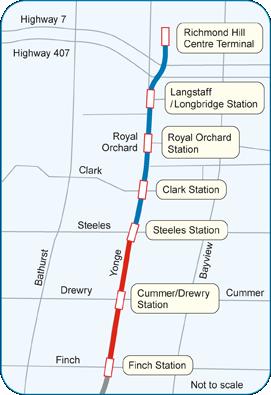
Many businesses in Thornhill along Yonge Street were convinced that reserved lanes for VIVA Phase 2 would be too disruptive. They were painted a picture of no disruption using tunneling methods, but were never told that cut-and-cover construction is needed where stations are placed.
From a business point of view, an underground option steals away potential business as commuters pass through the area without being able to see what is there. That said, let us keep the need for an underground solution in the area for the moment and look at what could be done with LRT technology placed underground between Steeles and Highway 7.
This line could come to the surface just north of Highway 7 for an at-grade station where the Richmond Hill Centre VIVA station currently is located.
Constructing an LRT line underground can cost between $130 million and $225 million per kilometre. Given that tunneling would not be the most complicated in this location (clay soil conditions, plenty of space without a large amount of underground services to be relocated), we will use $160 million per kilometre. This assumes the same stations as the subway plan, but the Richmond Hill Centre LRT station would be at grade, which makes for an easier transfer for riders between buses and LRT.
That underground four kilometres would cost $800 million, leaving $600 million.
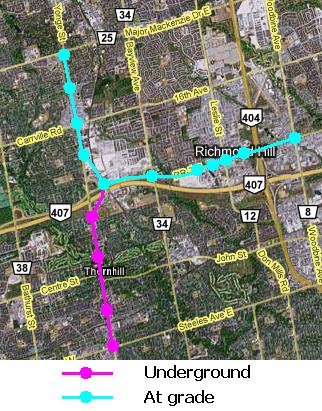
LRT on the surface can cost between $30 million and $60 million per kilometre. A right of way at the side of the road can be built using ballasted tie constructin for the low end of that range, while a concrete-encased right of way in the median of a road has an upper end cost. Except for specific places where the side of the road has benefits, we will assume the more expensive construction method for these examples.
That means there is enough funding remaining for 10 kilometres of surface line. Building the Yonge line all the way to Major MacKenzie (an additional 4 km) would cost $240 million, and another a 6 km line could be built along Highway 7 to Woodbine for the remaining $360 million.
Though a little more costly, it may be a good idea to have the Major MacKenzie station underground. Due to tight space from Major MacKenzie to Crosby Avenue (approximately 1 km), a future extension would be easiest if this stretch were tunneled. This possibility will be looked at later.

A possible future site on Yonge Street just south of Major MacKenzie Drive
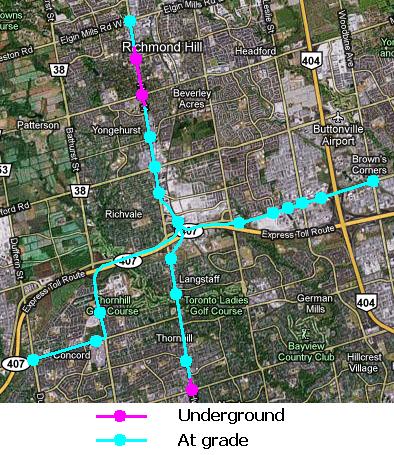
A faster, and more convenient transfer can be made with the Yonge Subway with an underground LRT terminal at Steeles. That idea is continued here, but the line returns to the surface and runs in a median to Yonge and Langstaff. At that point, the line can move off of Yonge Street to pass under the 407 and Highway 7. The cost of these underpasses pushes up the cost of the line, but the ROW east of Yonge Street would be lower cost as it would be tie-on-ballast construction, so the same per kilometre cost will be used.
With the first half kilometre underground from Steeles, that would cost $100 million. 7.5 kilometres to Major Mackenzie would cost another $450 million. This line could continue to Elgin Mills Road, but the 1 km stretch from Major Mackenzie to Crosby would have to be tunnelled as there is no room for a surface right of way. To cover the cost of portals at each end of this, the full $225 million for this kilometre is used in the estimate. This leaves another 1 km to Elgin Mills for a total of $835 million.
The remaining $565 million will build just over 10 km of surface LRT.
The current VIVA purple route between Dufferin (at Centre Street) Woodbine Avenue (at Highway 7) is about 11 km. The stretch of that route between Bathurst and Yonge coul be built in the strip of land between Highway 7 and the 407, which can cut its cost in half, making it possible to use this remaining funding for this construction.
Another cost savings would be by building the stretch from Yonge to Bayview the same way. This could even be extended almost another kilometre east, but this would involve a new underpass at Bayview, which would use up a significant part of this savings.
This plan provides 21 kilometres of rail transit for the same cost of 4 km of subway construction, using a mode that is more appropriate to the capacity needed for now and well into the future.
An important point to keep in mind, is that unlike Subway, LRT offers a very cost effective way of incremental expansion once the initial line is built. Extending a line a few kilometres, or building a branch off a line, is very cost effective.
Also, if at-grade platforms are initially built for 2-car trains, it is relatively easy and cost effective to extend these for 3-car trains if needed, especially in York Region where space makes a 3-car train practical.
Another advantage in York Region is that extensions into developing areas can take advantage of ROWs other than a roadway median. Building a line parallel to a main street often has costs at the lower end of the scale as ballasted tie construction may be used. Such construction is not practical if there are many intersections with side streets and driveways, but this can be controlled in a newly developing area.


In Minneapolis, traffic on Hiawatha Avenue is warned of an approaching LRT on the parallel ROW with a flashing sign (left photo) when arriving at an intersection. At the intersection, a lighted No Right Turn sign and crossing gates prevent traffic from passing until the LRT passes.
This page last updated January 14, 2011
